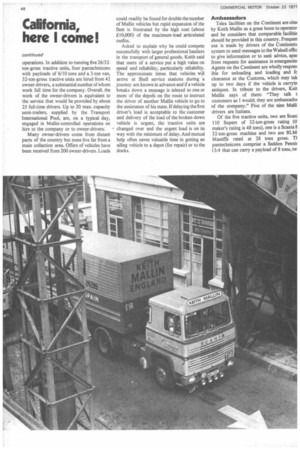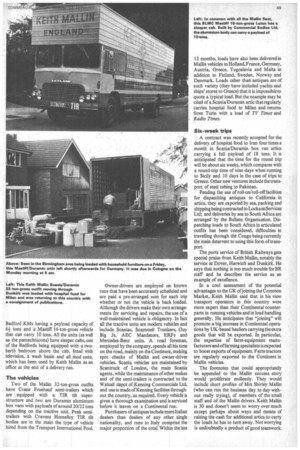California, here I come!
Page 49

Page 50

Page 51

If you've noticed an error in this article please click here to report it so we can fix it.
Well, that's one of the possibilities among the transport plans of a remarkable international haulier whose real business is antiques.
by Paul Brockington, MIMechE
KEITH MALLIN'S headquarters are in his antique dealer's office on the second floor of his Walsall antique shop that never opens. And from there he controls a fleet of vehicles, at least 20 of which are at any one time operating on the Continent (and as far afield as Iran) carrying antique furniture and other goods varying from yachts to hospital food. He started as an antique dealer eight years ago and two years later he drove a nine-yearold Austin 3-tonner on the first delivery of antiques by a company vehicle to a destination on the Continent. His wife, Shirley,. is the very active secretary of the company and knows the Continental scene at first hand.
When I visited Keith Mallin International Transport, 79 Ablewell Street, Walsall, Staffs, a few weeks ago, Keith himself had just returned from a 14-day visit to Sicily with a substantial order for antiques. Some eight days later the load had been collected from a variety of sources in widely dispersed centres and had been delivered to Palermo. After he had outlined the more routine aspects of his Continental operations, Keith casually mentioned that he had been asked to quote for transporting 200 tons of steel to India and 2m fountain pens to Bulgaria. A contract to take a load of antiques to Japan had been turned down because it would have involved crossing Vietnamese territory. He co operates closely with a partner in the antique business in California, and hopes that in due course antiques will be sent to California by a rollon/roll-off service between Southampton and Canada. The vehicles would be driven across the American continent to his partner's premises.
Continental operations are the on ly h aul age interest of the Mallin company apart from collections in the UK. Because the antiques arc sold to Mallin customers before they are transported, the company have been classed as professional hauliers from the start of operations. In addition to running five 26/32ton-gross tractive units, four pantechnicons with payloads of 6/10 tons and a 3-ton van, 32-ton-gross tractive units are hired from 42 owner-drivers, a substantial number of whom work full time for the company. Overall, the work of the owner-drivers is equivalent to the service that would be provided by about 25 full-time drivers. Up to 20 max. capacity semi-trailers, supplied by the Transport International Pool, are, on a typical day, engaged in Mallin-controlled operations on hire to the company or to owner-drivers: Many owner-drivers come from distant parts of the country but none live far from a main collection area. Offers of vehicles have been received from 200 owner-drivers. Loads could readily be found for double the number of Mallin vehicles but rapid expansion of the fleet is frustrated by the high cost (about £10,000) of the maximum-load articulated outfits.
Asked to explain why he could compete successfully with larger professional hauliers in the transport of general goods, Keith said that users of a service put a high value on speed and reliability, particularly reliability. The approximate times that vehicles will arrive at Shell service stations during a journey are known in advance and if a vehicle breaks down a message is telexed to one or more of the depots on the route to instruct the driver of another Mallin vehicle to go to the assistance of his mate. If delaying the first driver's load is acceptable to the customer and delivery of the load of the broken-down vehicle is urgent, the tractive units are changed over and the urgent load is on its way with the minimum of delay. And mutual help often saves valuable time in getting an ailing vehicle to a depot (for repair) or to the docks. Ambassadors Telex facilities on the Continent are cite( by Keith Mani as a great boon to operator and he considers that comparable facilitie should be provided in this country. Frequen use is made by drivers of the ContinentE system to send messages to the Walsall offic to give information or to seek advice, vat from requests for assistance in emergenciel Agents on the Continent are wholly responi ible for unloading and loading and fc clearance at the Customs, which may talc up to two days if the vehicle is carryin antiques. In tribute to the drivers, Keit Mallin says of them: "They talk t customers as I would; they are ambassadoi of the company." Five of the nine Maffi drivers are Italians.
• Of the five tractive units, two are Scan 110 Supers of 32-ton-gross rating (tt maker's rating is 48 tons), one is a Scania 8 32-ton-gross machine and two are BLIA Mastiffs rated at 28 tons gross. T1 pantechnicons comprise a Seddon Penni' 13:4 that can carry a payload of 8 tons, tw Bedford KMs having a payload capacity of 6+ tons and a Mastiff 16-ton-gross vehicle that can carry 10 tons. All the units (as well as the pantechnicons) have sleeper cabs, one of the Bedfords being equipped with a twoberth bedroom above the cab, fitted with television, a wash basin and all mod cons, which has been used by Keith Mallin as an office at the end of a delivery run.
The vehicles Two of the Mallin 32-ton-gross outfits have Crane Fruehauf semi-trailers which are equipped with a TIR tilt superstructure and two are Duramin aluminium box vans with payloads of around 20/22 tons depending on the tractive unit. Peak semitrailers with Cravens Homalloy TIR tilt bodies are in the main the type of vehicle hired from the Transport International Pool. Owner-drivers are employed on known runs that have been accurately scheduled and are paid a pre-arranged sum for each trip whether or not the vehicle is back loaded. Although the drivers make their own arrangements for servicing and repairs, the use of a well-maintained vehicle is obligatory. In fact all the tractive units are modern vehicles and include Scanias, Scammell Trunkers, Guy Big Js, AEC Mandators, ERFs and Mercedes-Benz units. A road foreman, employed by the company, spends all his time on the road, mainly on the Continent, making spot checks of Mallin and owner-driver vehicles. Scania vehicles are maintained by Scantruck of London, the main Scania agents, while the maintenance of other makes and of the semi-trailers is contracted to the Walsall depot of Kenning Commercials Ltd, and use is made of Kenning facilities throughout the country, as required. Every vehicle is given a thorough examination and is serviced before it leaves on a Continental run.
Purchasers of antiques include more Italian dealers than dealers of any other single nationality, and runs to Italy comprise the major proportion of the total. Within the last
12 months, loads have also been delivered in Mallin vehicles to Holland, France, Germany, Austria, Greece, Yugoslavia and Malta in addition to Finland, Sweden, Norway and Denmark. Loads other than antiques are of such variety (they have included yachts and ships' stores to Greece) that it is impossible to quote a typical load. But the example may be cited of a Scan ia/Duramin artic that regularly carries hospital food to Milan and returns from Turin with a load of TV Times and , Radio Times.
Six-week trips A contract was recently accepted for the delivery of hospital food to Iran four times a month in Scania/Duramin box van artics carrying a full payload of 18 tons. It is anticipated that the time for the round trip will be about six weeks, which compares with a round-trip time of nine days when running to Sicily and 10 days in the case of trips to Greece. Other new ventures include the transport of steel tubing to Pakistan.
Pending the use of roll-on/roll-off facilities for dispatching antiques to California in artics, they are exported by sea, packing and shipping being contracted to LocksonServices Ltd; and deliveries by sea to South Africa are arranged by the Bullens Organisation. Dispatching loads to South Africa in articulated outfits has been considered, difficulties in travelling through the Congo being currently the main deterrent to using this form of transport.
The ports service of British Railways gets special praise from Keith MallM, notably the service at Dover, Harwich and Dunkirk. He says that nothing is too much trouble for BR staff and he describes the service as an example of excellence.
In a cool assessment of the potential advantages to the UK ofjoining the Common Market, Keith MOM said that in his view transport operators in this country were more expert than their Continental counterparts in running vehicles and in load handling generally. He anticipates that "joining" will promote a big increase in Continental operations by UK-based hauliers carrying the extra goods that will be exported. In particular, the expertise of farm-equipment manufacturers and of farming specialists is expected to boost exports of equipment. Farm tractors are regularly exported to the Continent in Mallin vehicles.
The footnotes that could appropriately be appended to the Mallin success story would proliferate endlessly. They would include short profiles of Mrs Shirley Mallin (who can run the business day to day without really trying), of members of the small staff and of the Mallin drivers. Keith Mallin is 30 and doesn't seem to worry over much except perhaps about ways and means of raising the cash for additional artics to carry the toads he has to turn away. Not worrying is undoubtedly a product of good teamwork.








































































































